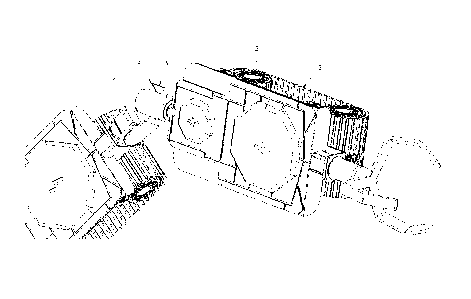Une partie des informations de ce site Web a été fournie par des sources externes. Le gouvernement du Canada n'assume aucune responsabilité concernant la précision, l'actualité ou la fiabilité des informations fournies par les sources externes. Les utilisateurs qui désirent employer cette information devraient consulter directement la source des informations. Le contenu fourni par les sources externes n'est pas assujetti aux exigences sur les langues officielles, la protection des renseignements personnels et l'accessibilité.
L'apparition de différences dans le texte et l'image des Revendications et de l'Abrégé dépend du moment auquel le document est publié. Les textes des Revendications et de l'Abrégé sont affichés :
| (12) Demande de brevet: | (11) CA 2906857 |
|---|---|
| (54) Titre français: | ROBOT FLEXIBLE HAUTE PUISSANCE A GRANDE MOBILITE |
| (54) Titre anglais: | A HIGH MOBILITY, HIGN POWER, AND FLEXIBLE ROBOT |
| Statut: | Réputée abandonnée et au-delà du délai pour le rétablissement - en attente de la réponse à l’avis de communication rejetée |
| (51) Classification internationale des brevets (CIB): |
|
|---|---|
| (72) Inventeurs : |
|
| (73) Titulaires : |
|
| (71) Demandeurs : |
|
| (74) Agent: | |
| (74) Co-agent: | |
| (45) Délivré: | |
| (22) Date de dépôt: | 2015-10-06 |
| (41) Mise à la disponibilité du public: | 2017-04-06 |
| Licence disponible: | S.O. |
| Cédé au domaine public: | S.O. |
| (25) Langue des documents déposés: | Anglais |
| Traité de coopération en matière de brevets (PCT): | Non |
|---|
| (30) Données de priorité de la demande: | S.O. |
|---|
A high mobility and high power robot, designed to be able to carry heavy packs
and payloads
over long distances on the ground, and be able to safely cross over high
walls, descend into
steep drops, cross over narrow chasms, and climb trees and other vertical
structures, using
back-drivable motors and a sectioned body shape. The limits of the robot's
mobility on the
ground depend only on its body length, which is adjustable. The power of the
robot depends on
the sizes and designs of the robot's power sources and motors, which are
adjustable.
A high mobility, high power, and flexible robot.
Background of the Invention
Field of the Invention:
The invention belongs to the field of mechatronics. An interdisciplinary field
that combines
mechanical engineering and electronic engineering. The invention shares
similarities with a
class of robots commonly referred to as unmanned ground vehicles. Unmanned
ground
vehicles (UGV) are electromechanical systems that can be either autonomous or
remotely
controlled to perform a wide variety of tasks. UGVs are generally wheeled
platforms, actuated
by motors, and carry customized tools/payloads that allow them to perform a
variety of tasks.
Unlike stationary robots, these UGV systems are mobile and can travel around
the ground.
The invention possesses a level of mobility and power beyond that of any
grounded robots or
unmanned systems currently existing. It is able to carry heavy equipment packs
and payloads
over long distances, can safely climb over high walls, descend steep drops in
terrain, cross over
narrow chasms, and even climb trees/vertical structures. A combination of
mobility and power
makes this invention unique and stand out from all other developed robotics or
unmanned
systems.
Note : Les revendications sont présentées dans la langue officielle dans laquelle elles ont été soumises.
Note : Les descriptions sont présentées dans la langue officielle dans laquelle elles ont été soumises.

2024-08-01 : Dans le cadre de la transition vers les Brevets de nouvelle génération (BNG), la base de données sur les brevets canadiens (BDBC) contient désormais un Historique d'événement plus détaillé, qui reproduit le Journal des événements de notre nouvelle solution interne.
Veuillez noter que les événements débutant par « Inactive : » se réfèrent à des événements qui ne sont plus utilisés dans notre nouvelle solution interne.
Pour une meilleure compréhension de l'état de la demande ou brevet qui figure sur cette page, la rubrique Mise en garde , et les descriptions de Brevet , Historique d'événement , Taxes périodiques et Historique des paiements devraient être consultées.
| Description | Date |
|---|---|
| Le délai pour l'annulation est expiré | 2018-10-09 |
| Demande non rétablie avant l'échéance | 2018-10-09 |
| Réputée abandonnée - omission de répondre à un avis sur les taxes pour le maintien en état | 2017-10-06 |
| Demande publiée (accessible au public) | 2017-04-06 |
| Inactive : Page couverture publiée | 2017-04-05 |
| Inactive : CIB attribuée | 2015-10-30 |
| Inactive : CIB en 1re position | 2015-10-30 |
| Exigences de prorogation de délai pour compléter le paiement de la taxe applicable aux petites entités - jugée conforme | 2015-10-22 |
| Inactive : Certificat dépôt - Aucune RE (bilingue) | 2015-10-14 |
| Exigences de dépôt - jugé conforme | 2015-10-14 |
| Demande reçue - nationale ordinaire | 2015-10-09 |
| Inactive : CQ images - Numérisation | 2015-10-06 |
| Inactive : Pré-classement | 2015-10-06 |
| Inactive : CQ images - Numérisation | 2015-10-06 |
| Déclaration du statut de petite entité jugée conforme | 2015-10-06 |
| Déclaration du statut de petite entité jugée conforme | 2015-10-06 |
| Date d'abandonnement | Raison | Date de rétablissement |
|---|---|---|
| 2017-10-06 |
| Type de taxes | Anniversaire | Échéance | Date payée |
|---|---|---|---|
| Taxe pour le dépôt - générale | 2015-10-06 |
Les titulaires actuels et antérieures au dossier sont affichés en ordre alphabétique.
| Titulaires actuels au dossier |
|---|
| LEO HOWARD |
| Titulaires antérieures au dossier |
|---|
| S.O. |